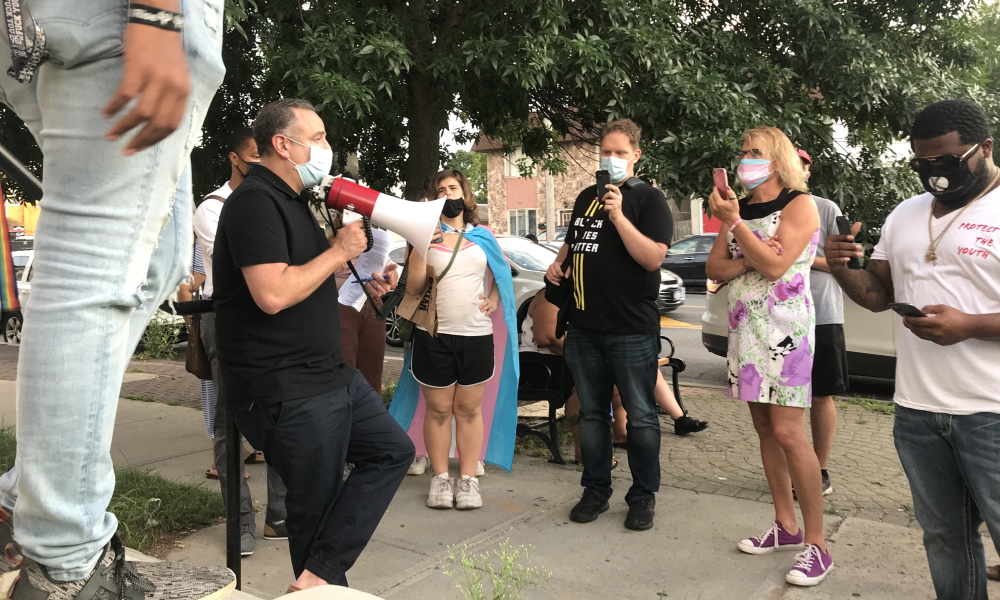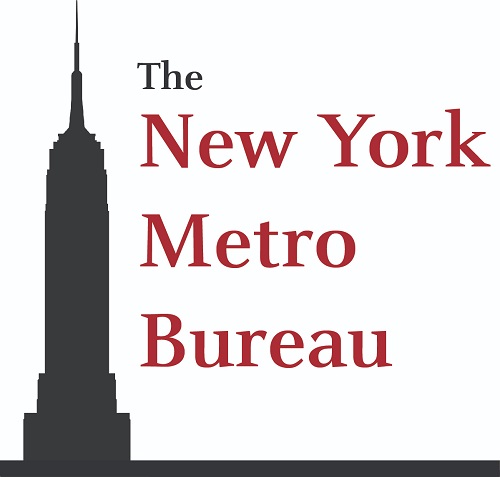
Gabe Stern
All of Us protesters meet with Lt. Ryan Macherone, of the Schenectady Police Department, at a community discussion on July 29.
SCHENECTADY, New York — After an arrest that thrust the Schenectady Police Department into the national spotlight due to another knee-to-head chokehold on a person of color, the front steps of City Hall became the backdrop for the two different responses that would follow.
Schenectady NAACP President Odo Butler called for outrage to turn into policy shifts on July 11, standing next to Police Chief Eric Clifford. He was echoing a familiar sentiment in the small city of 65,000, separated from Manhattan by nearly three hours of suburban highway along the Hudson River.
Clifford had already approved five preliminary police reforms days before.
Two days later, dozens of protesters from the activist group All of Us marched up those steps and blocked all entrances to City Hall. The group had its own 13 demands, garnered through community input. One was a ban on all chokeholds and hogties. Others included defunding the police department and firing officers with racist social media posts.
“It’s changing how the criminal justice system operates, reallocating funds,” said organizer Mikayla Foster, 21. “But on a deeper scale, it’s a discussion about the effects of capitalism. It’s a discussion about the effects on what our failing democracy looks like.”
The sweeping reforms taking place in Minneapolis, Los Angeles and New York City are also landing on the city hall steps of smaller towns like this one as city government tests the patience of many activists who have already reached their boiling point.
The viral video of the July 6 arrest ignited this process in Schenectady, renewing the urgency for two already existing avenues of change: one that embraces the monthslong process that can precede police reforms, and one that rejects the process in favor of protests.
The local NAACP and several organizations have had long discussions with the mayor and police chief, mostly via private conversations about what police reforms could look like in the months ahead. This led to the creation of a police reform task force, which Clifford said will later turn into police reform measures that will coincide with Gov. Andrew Cuomo’s executive order.
The other avenue is through protests that call for faster, more structural changes, spearheaded in part by young activists who see the current legislative process as long-tried and broken. These activists have little faith in government reform.
“I think people in leadership positions previously were able to say, ‘You know what, we’re just Schenectady, we’re just a little town,” said Carl Williams, a member of the Schenectady NAACP. “It’s understanding that at any moment, you can be the next big thing.”
‘Everything takes time’
Organizers from All of Us had made phone calls and held events to define what their demands would be: What went wrong in their city of about 66,000 people?
There was the killing of Andrew Kearse, a Black man who died in police custody in 2018. Activists were upset that the store Bumpy’s was closed over health violations when they were protesting the owner’s alleged racist texts. And then there was the July 6 arrest of Yugeshwar Gaindarpersaud, the Guyanese resident.
The 13 demands by All of Us were a mix of mainstream reforms and wholesale changes that they said would restructure how the justice system here works, such as automatic firing for private, racist conversations by officers; a ban on shooting at moving vehicles, and profits from seized drugs and drug charges diverted “back to the community.”
 In a July 12 meeting with Mayor McCarthy and Chief Clifford the day before they marched, Miles and Foster asked which of their demands could be implemented immediately.
In a July 12 meeting with Mayor McCarthy and Chief Clifford the day before they marched, Miles and Foster asked which of their demands could be implemented immediately.
“Their answer was, ‘Well, everything takes time,’” Miles told the media on July 13 during the protest. “[But] they still, in 24 hours, turned [five NAACP reforms] around. So we will not be moved until we get at least one of those demands met.”
With no progress nearly nine hours later, just before 1 in the morning, Miles asked a question the group had wondered about for months:
“So what’s it gonna take for us to show him that we truly represent the city in our demands?”
Tides ‘slowly start to turn’
On the morning of July 6, hours before the viral arrest, Chief Clifford and Mayor McCarthy sat down with Richard Shave and Carl Williams, two members of Schenectady’s Civilian Police Review Board (CPRB). The group was created to provide a citizen-led branch of the oversight process; yet the members were mayor-appointed, the board has no subpoena power and they’ve historically struggled with funding.
Shave, now the president of the CPRB, saw the “tides slowly start to turn,” he said. It was one in a series of private, preliminary discussions that Clifford and McCarthy sat in behind closed doors to discuss reforms — discussions that All of Us protesters didn’t know about.
“It really is a collective of multiple organizations that is both powerful and a detriment to itself where they have pockets of supporters and we haven’t been able to communicate together as much as we would like to,” said Williams, a member of the NAACP, speaking on behalf of himself. “So we have not been able to submit one voice.”
The five reforms came from the next meeting, two days later, as Clifford met with members of the local NAACP, CPRB and city council. The city banned knee-to-head holds and added restrictions on warrantless arrests. They committed to further develop the CPRB, among others.
Those are still the only reforms implemented. The investigation of Lt. Brian Pommer, who put the chokehold on Gaindarpersaud, is ongoing.
At a July 20 virtual city council meeting, Councilor Marion Porterfield, a member of the Schenectady NAACP, tried to start a public plan. She asked for input about potential police reforms that would coincide with Cuomo’s executive order.
She was met with 20 seconds of silence, then the council moved onto the next topic.
On July 24, the city introduced the Police Reform and Reinvention Task Force. McCarthy, Clifford, Butler and leaders of Schenectady’s Guyanese community, among others, will set a timeline and discussion points to focus on “actionable outcomes” and seek police reforms “where appropriate.”
“There’s a communication gap, and their [protesters’] perception is also their reality,” said the NAACP’s Williams. “So it doesn’t matter if Chief Clifford is at this desk saying ‘You know what, I support their movement, I support moving forward’ and there’s no plan.”
Questions with few answers
At the next listening session, on July 29, questions turned to arguments between clergy and protesters over whether the police officers owed them this listening session or whether these should be mandatory.
“They don’t have to do this,” said Arnetta Dix, a pastor at Refreshing Springs Church.
“Yes, they do have to do this,” said an All of Us protester. “They’re paid employees.”
On the front steps of Grace and Mercy Church, Lt. Ryan Macherone wrote down the concerns All of Us had: not enough outreach for community meetings. Improper training for officers. Outrage that hogties and strangleholds still weren’t banned, over three weeks after Gaindarpersaud’s arrest went viral.
Protesters asked him why there were only two officers in charge of community outreach, why Pommer had not yet been fired and what he personally thought of the arrest — independent of his role as a lieutenant.
Macherone said he wasn’t authorized to answer that.
Minutes later, a protester asked a question that morphed into a statement.
“Do you not understand the urgency of this stuff that needs to be done?” they asked. “… the things that need to be changed needed to be changed weeks ago. Months ago. And we don’t have time to wait. There’s no time to wait. This needs to be done now. And I know there’s not much of a question in there, and I’m sorry, but that’s just kind of where we’re at.”
It wasn’t a question. Macherone had no answer. He took the megaphone back and handed it to the next person.































